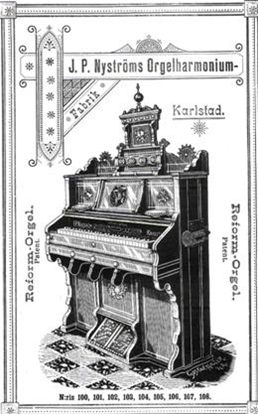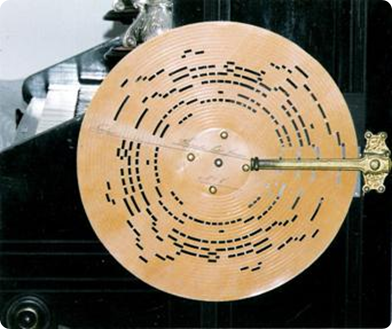klaverens hus 
We are still working with this site. Plaese, check the changes regularly.  Ändra den här texten genom att klicka på "Redigera" |
J. P. Nyström, Karlstad,Large ’reform’ reed organ 1895-1901 (KH 40)
Self-playing reed organs became common at the end of the 19th century. They had the advantage that they were played both as a usual organ and with a crank like a big music box, mainly for use in chapels and private homes. The J.P. Nyström factory in Karlstad made what he called ‘reform’ reed organs from c. 1890 to c. 1920. Other manufacturers of grind reed organs were C.A.V. Lundholm in Stockholm and P.A. Lindahl in Kalmar.
The instrument has ‘except a usual keyboard for use by those who have learnt how to play the organ also a mechanism intended for those who don’t know how to play it.’ A pin-hole music disc is attached to the mechanism on the right side of the organ, a crank is turned around and the organ is ‘not far off playing any music.’ Wihelm Nyström, the son of Johan Petter Nyström, constructed music copying and punching machines for this ‘reform’ reed organ. Six pin-hole music discs were sold together with every organ. Extra discs were for sale for 1 crown each or 90 öre per dozen. The repertoire comprised for example patriotic songs, chorals, marches, dances and temperance movement songs, i.e. music for moral building up and strength and for worldly pleasures and amusements.
Klaverens Hus, Hemmansvägen 11 826 62 NORRALA +46722820431 info@klaverenshus.se www.klaverenshus.se
|

